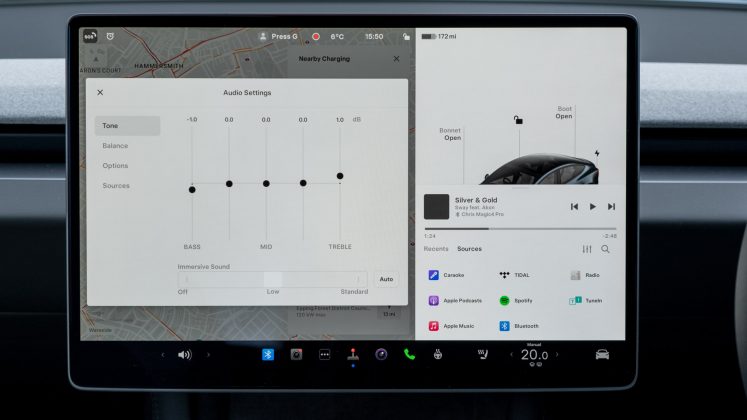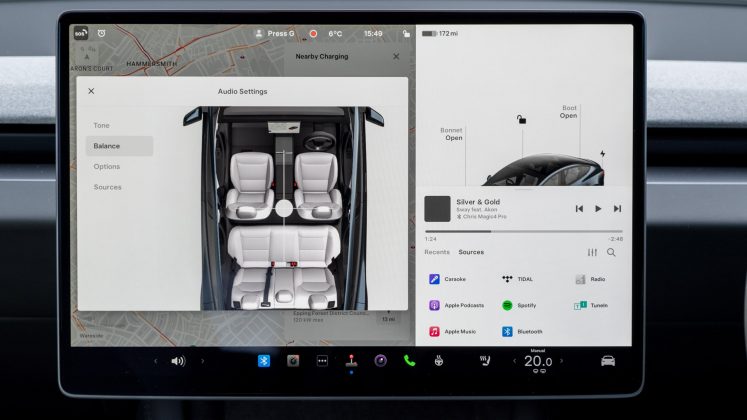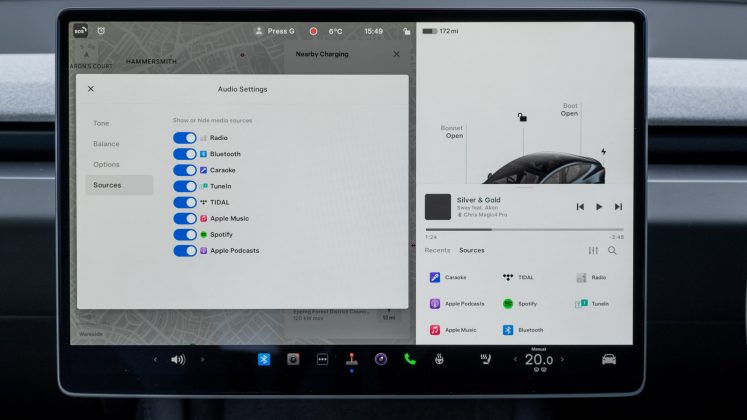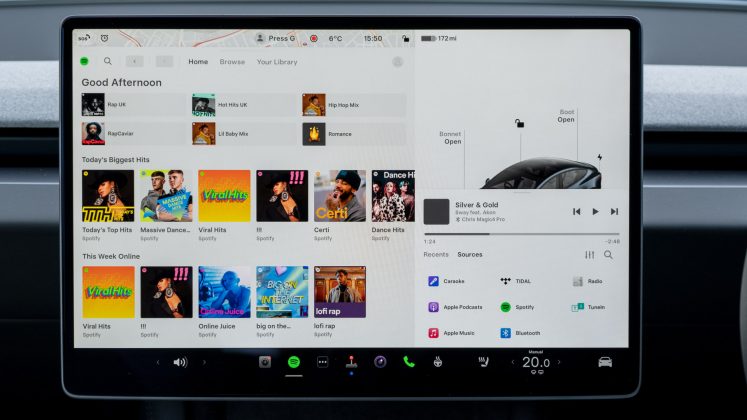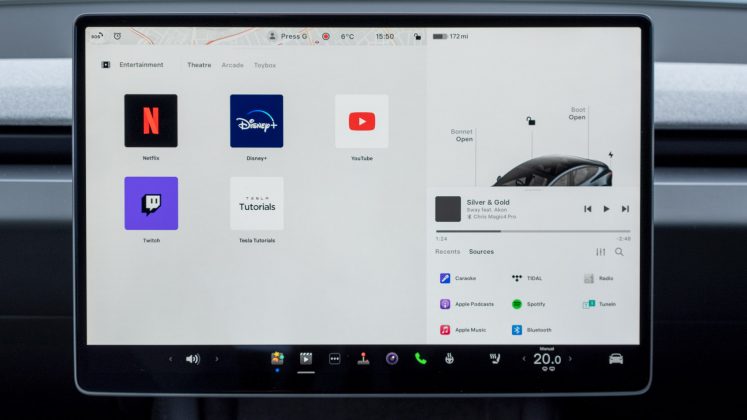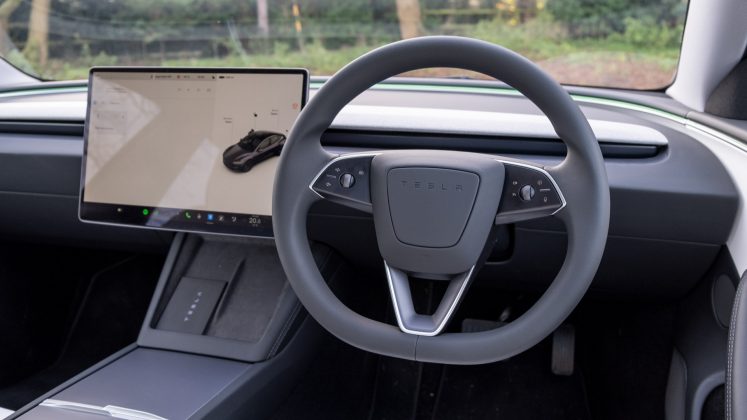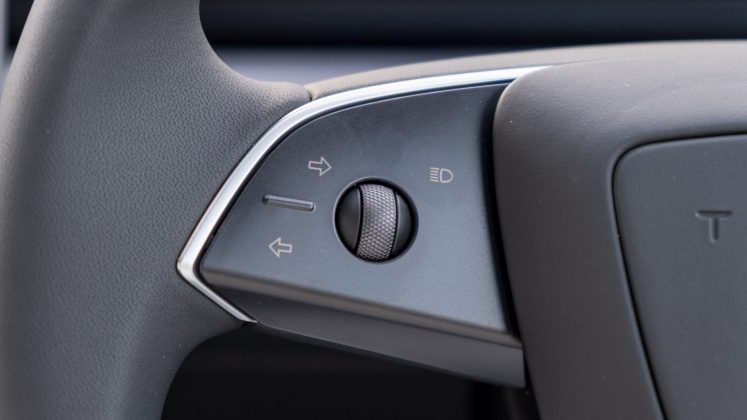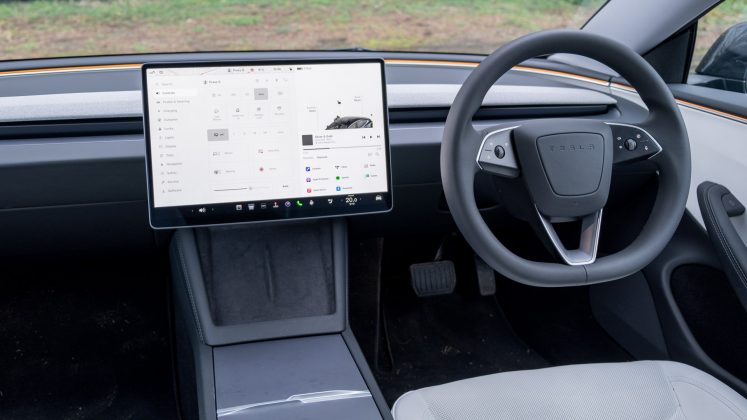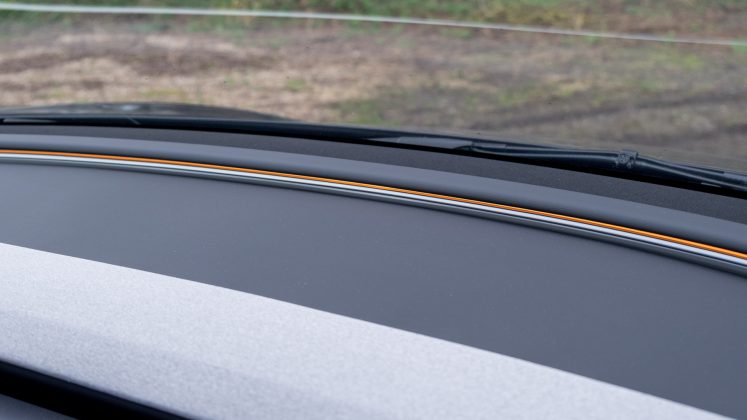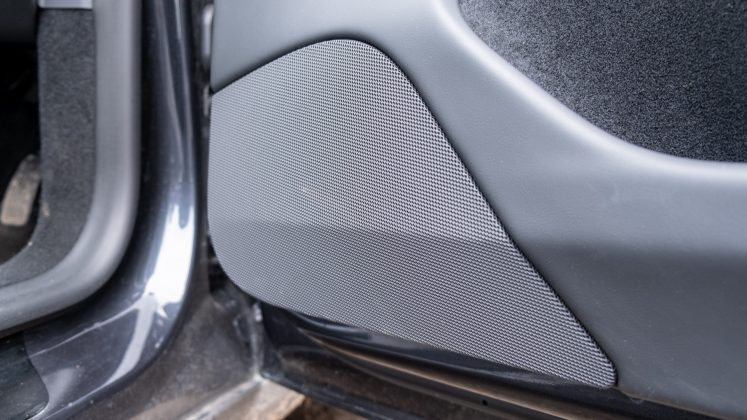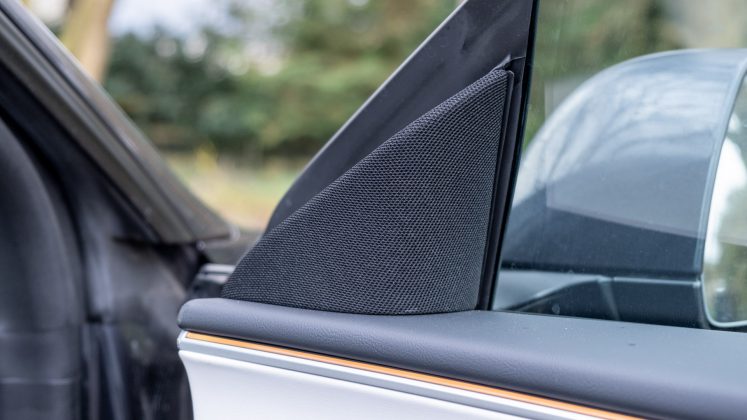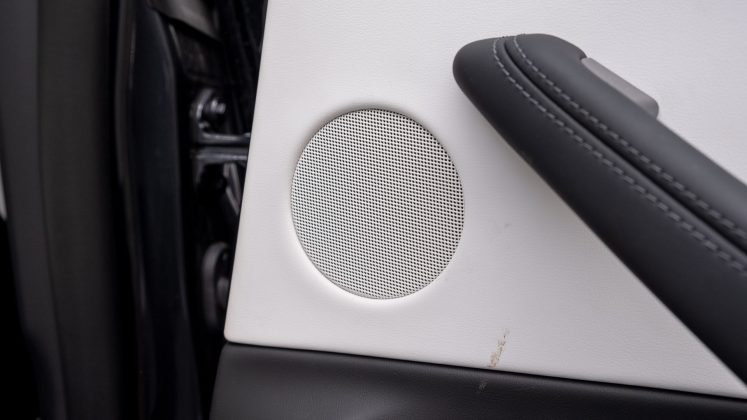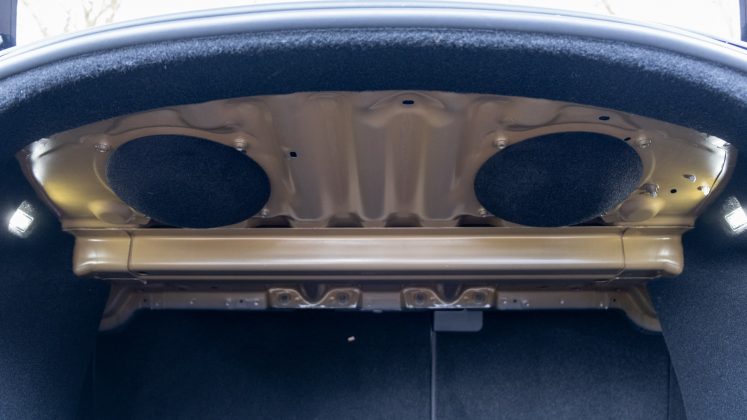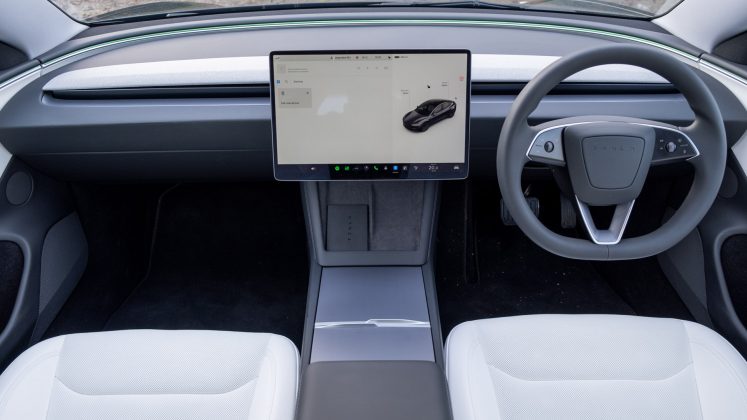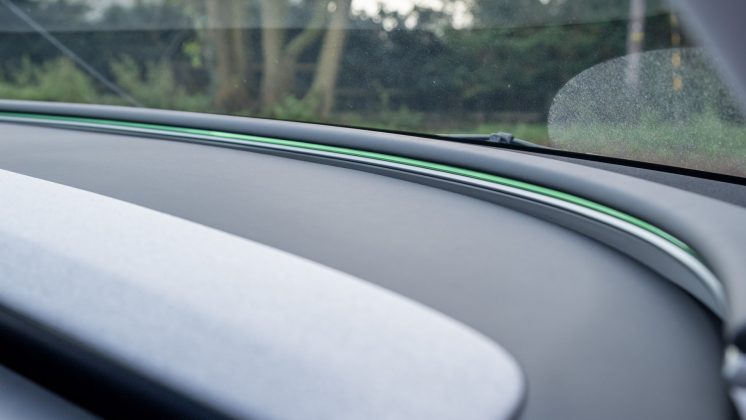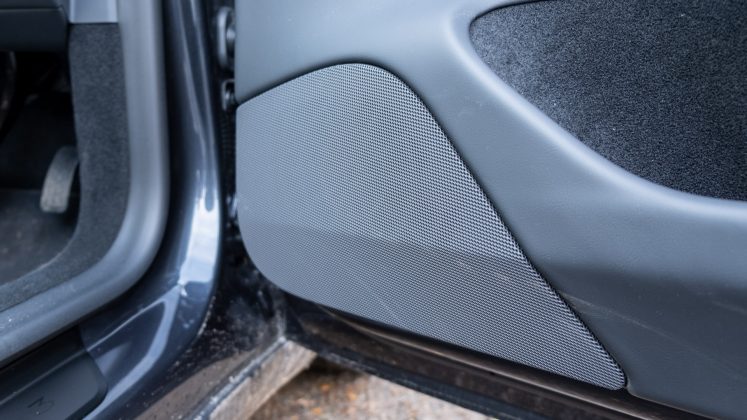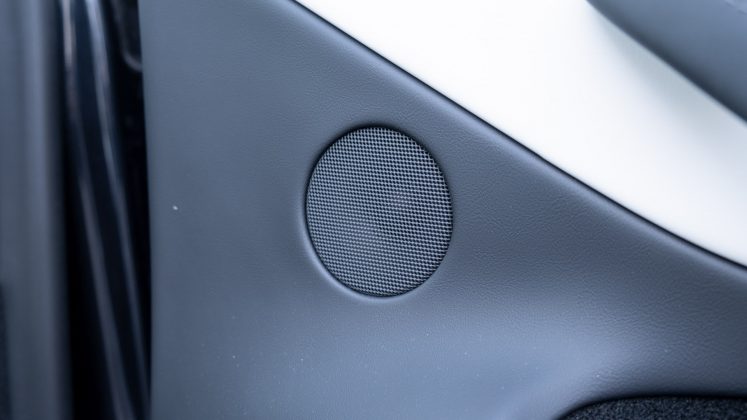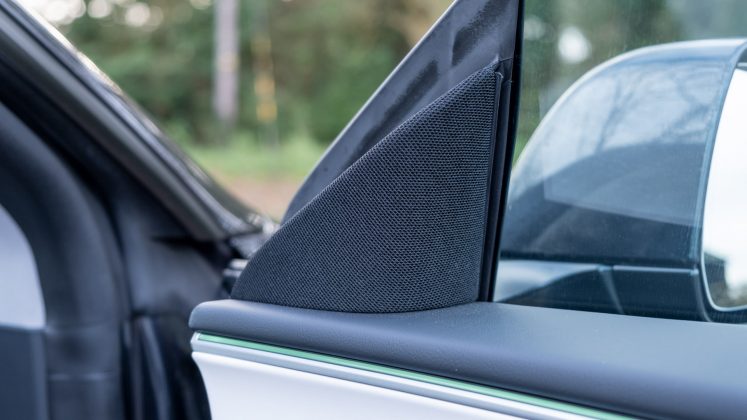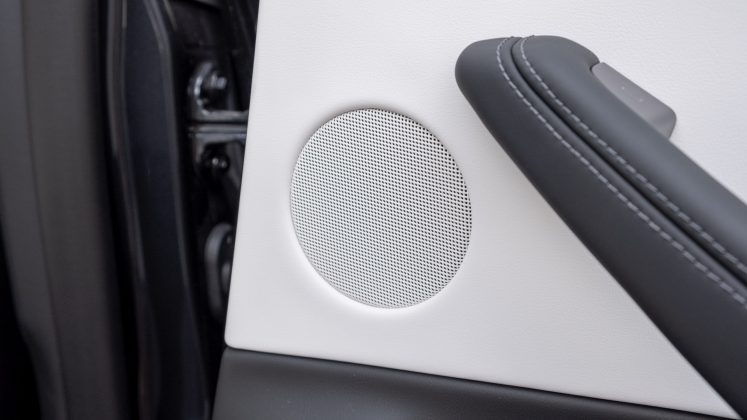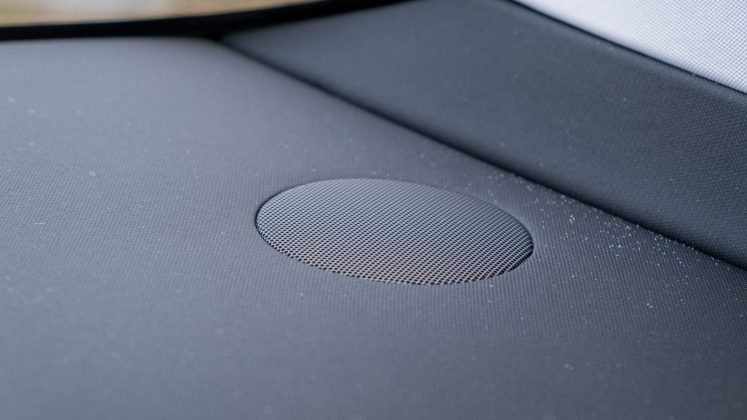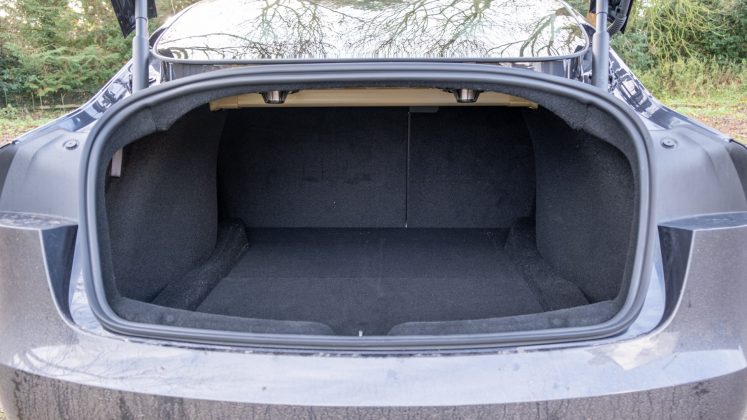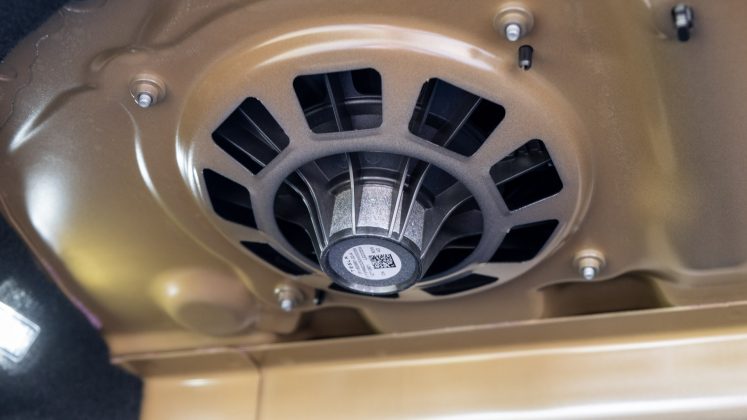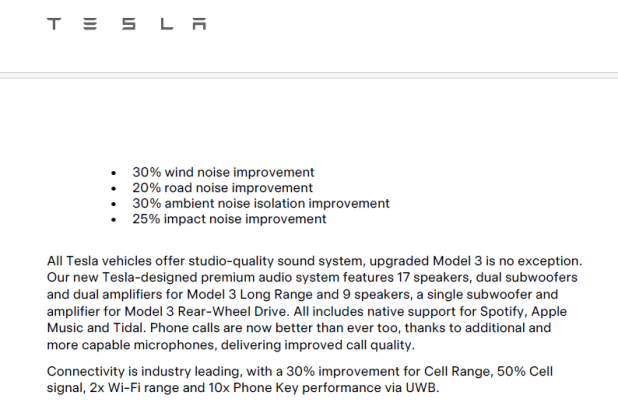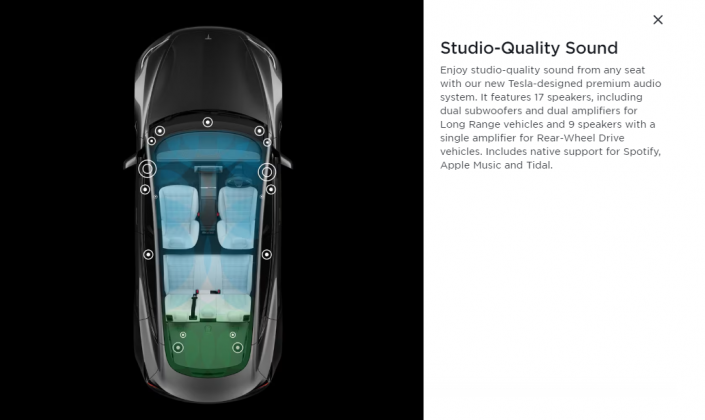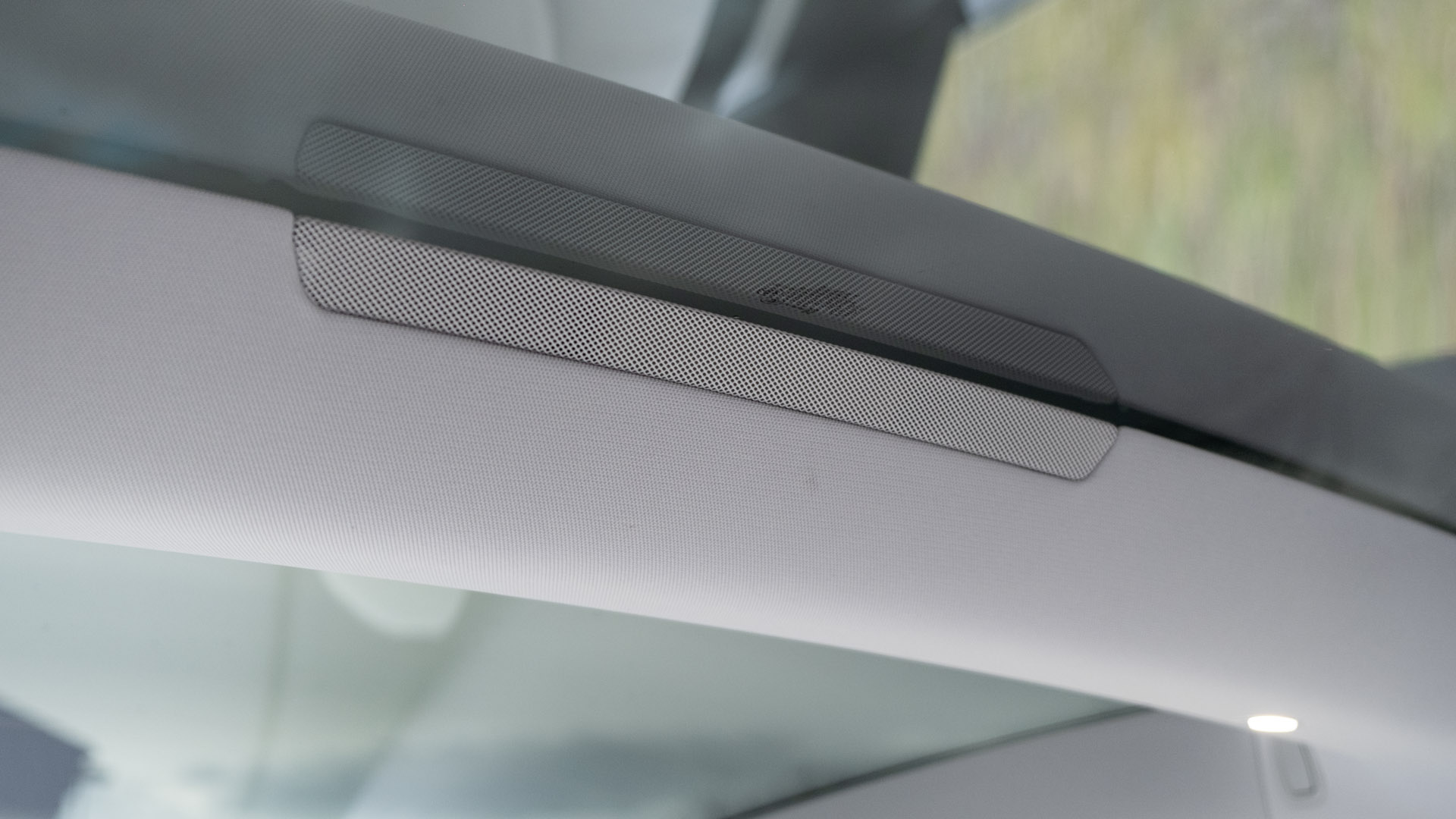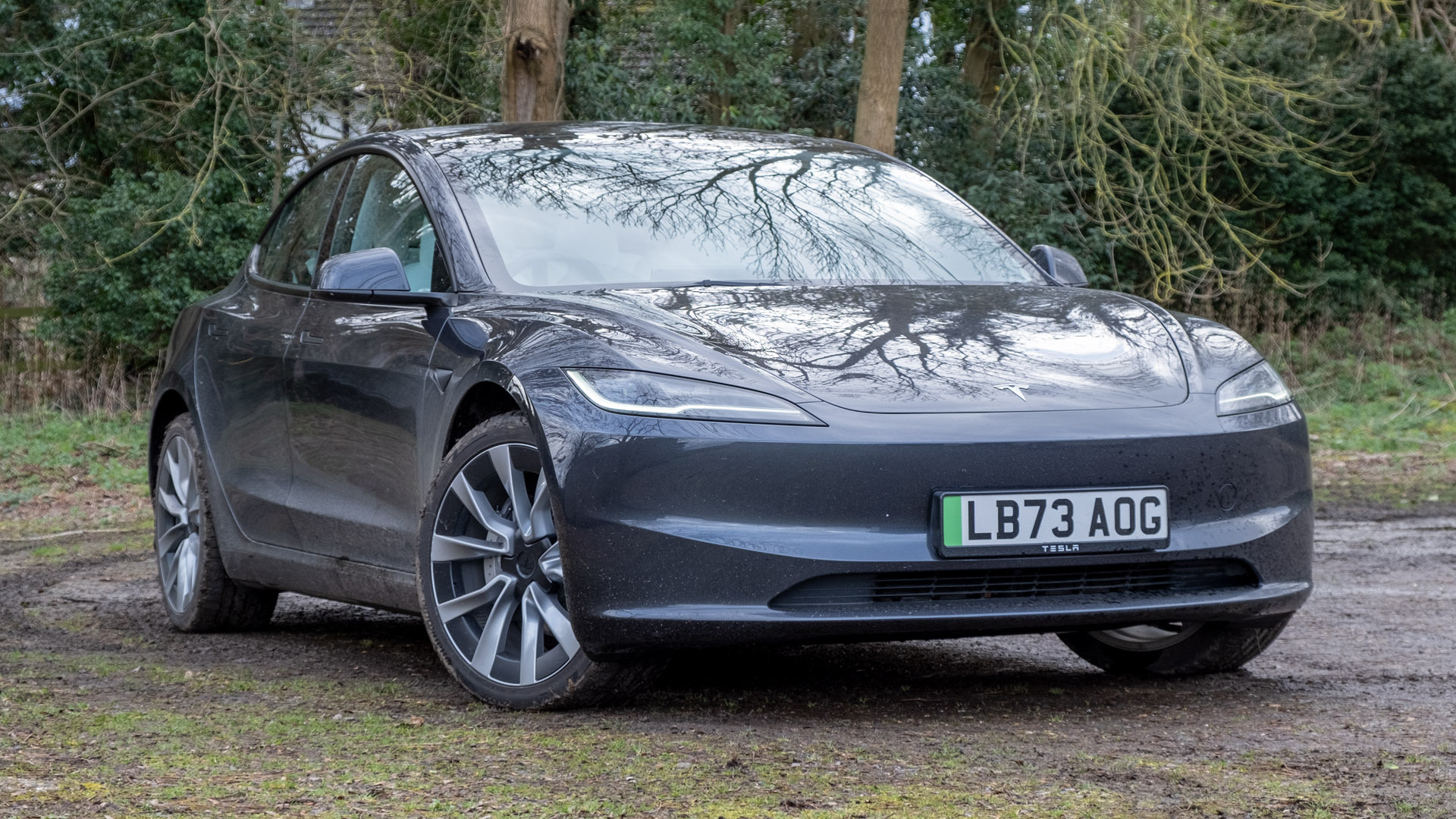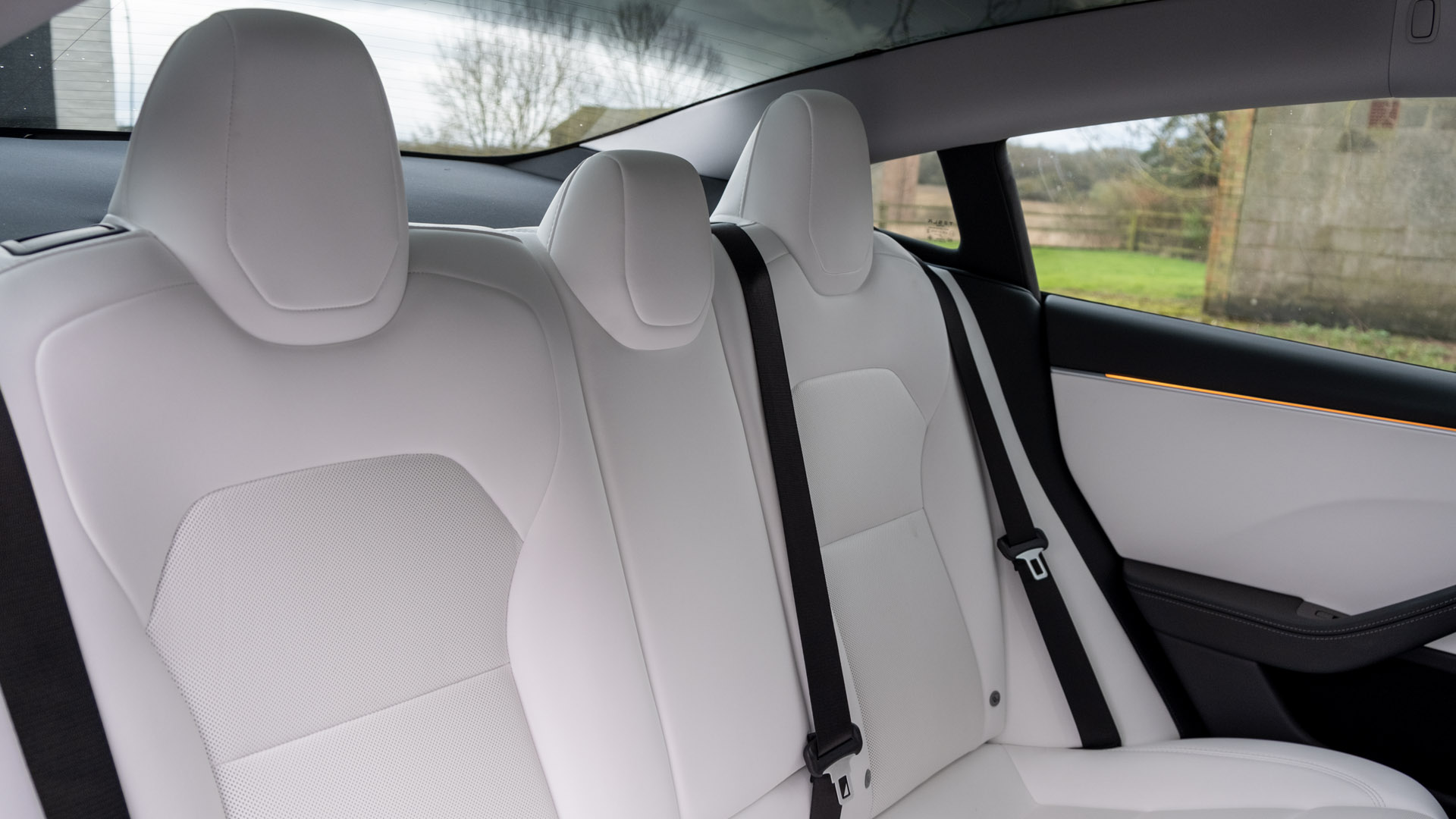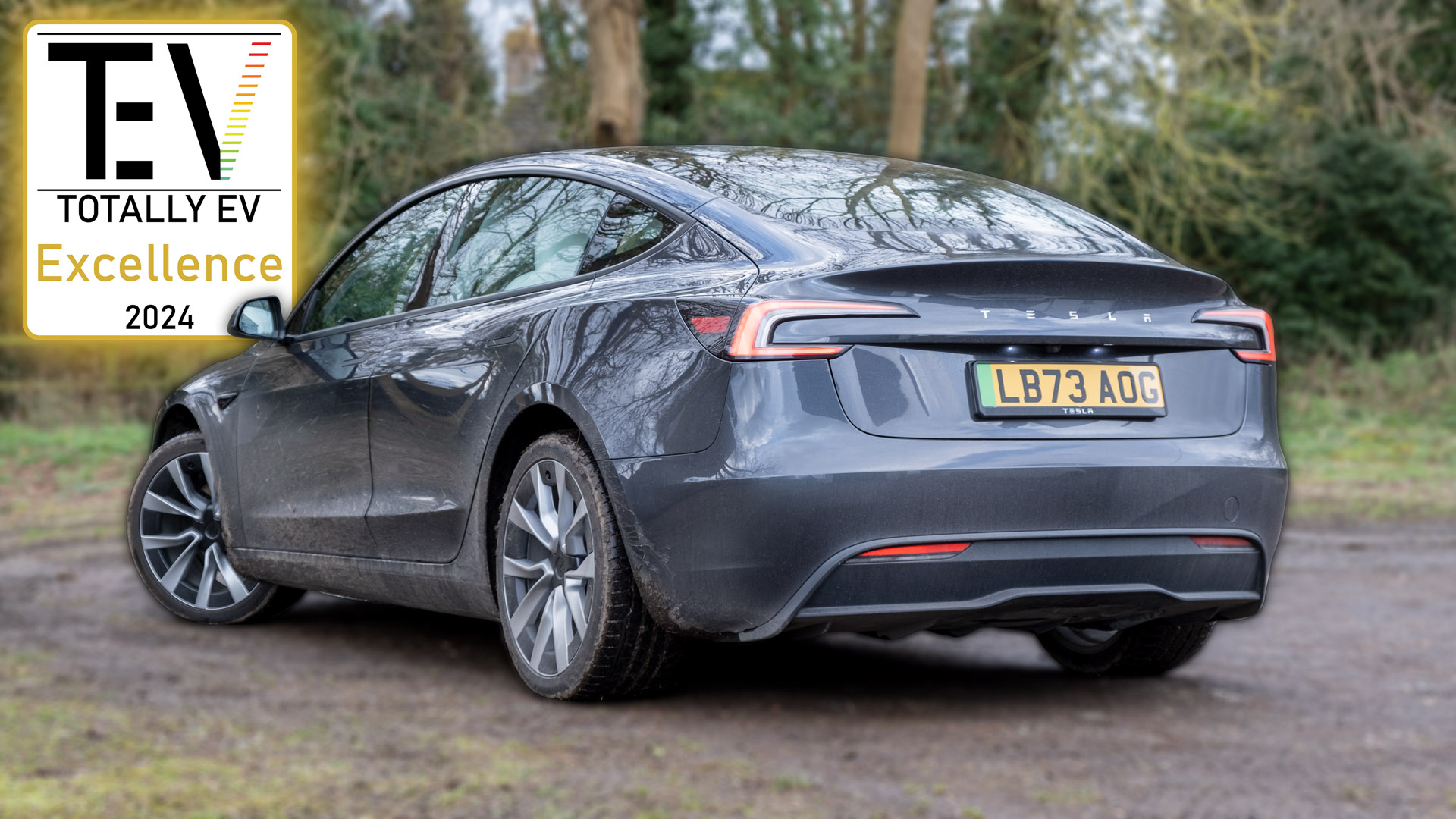The new Tesla Model 3 Highland builds upon its predecessor by incorporating a few notable upgrades, such as its refined interior and exterior design, a more advanced suspension system, good range, and excellent performance all while remaining competitively priced. Despite losing its indicator stalks and falling short in some key areas over its rivals, it’s still an impressive electric vehicle and as such, received our Best Buy award.
Regarding its audio configuration, the new entry-level Model 3 rear-wheel drive (RWD) has nine speakers, while the new all-wheel drive (AWD) model has a 17-speaker system with two upward-firing subwoofers in the boot. We already reviewed the latter system, but here we will be concentrating on the former configuration.
Indeed, the new Model 3 has an upgraded audio configuration. The RWD model used to have eight speakers (later dropped to seven), while the AWD model used to have 15 speakers (later dropped to 14). When compared, the new RWD model now has tweeters at the front of the cabin. The AWD model now has two subwoofers as opposed to only one in the boot, while each of the front doors now houses two woofers versus the singular unit that was present in the past.
Click here to read the full Tesla Model 3 review
Tesla Model 3 audio setup
To tweak the audio settings, one has to navigate through the 15.4″ infotainment system to find the appropriate menu. Here are our optimal settings:
- Bass: -1
- Lower-mids: +0
- Mids: +0
- Upper-mids: +0
- Treble: +1
- Immersive Sound: Low/+1 (or -1 from Standard)
- Balance & Fader: Centre
To connect to the vehicle’s audio system using your smartphone, you’ll be limited to using Bluetooth only – the USB Type-C ports are all used for charging only. As Tesla’s infotainment system doesn’t support Android Auto or Apple CarPlay, this is the only way to playback media files from a phone.
Unfortunately, the SBC codec is supported only, which is a downgrade over its predecessor that supported both the SBC and AAC codecs – the latter being useful for iPhone owners, as it’s Apple’s native codec. Further, it’s a shame that higher quality codecs such as aptX or LDAC aren’t supported, as it would have reduced the transmission loss and thus improved the audio quality over Bluetooth.
On the plus side, there is the option to plug a flash drive into the USB Type-A port found in the glove box. It must be formatted to FAT32 or exFAT and should you wish to continue using the dashcam feature, you’ll need to partition the drive. Once utilised, you’ll be able to playback MP3 and higher-resolution files that have been recorded in the FLAC (Free Lossless Audio Codec File) and WAV formats – up to 24-bit 192 kHz is supported. This makes the Model 3 among a finite group of cars that can support higher-resolution playback over USB, which is ideal for budding audiophiles.
Read next: A list of our favourite phone holders
Aside from your traditional inputs, there is ‘Premium Connectivity’, which is a subscription that costs £10 a month. This gives you the ability to stream music at a higher quality by using Apple Music, Spotify and Tidal, with video streaming platforms Netflix, YouTube and Twitch also available as alternatives.
As for media controls, there are the onscreen touch controls and the physical left scroll wheel on the steering wheel. When pressed it pauses or resumes, and when it’s shifted to the left or right will go back or skip a track, respectively. If you roll the wheel upwards or downwards it’ll adjust the overall playback volume.
Read next: New Tesla Model 3 audio review: Upgraded to 17 speakers
Tesla Model 3 audio performance
For a demo of the Tesla Model 3’s audio system, head on over to our YouTube channel.
In terms of its audio configuration, the manufacturer hasn’t confirmed all the details with its systems, with total wattage also kept secret. However, we do know that the new Model 3 RWD has nine speakers and has the following setup: three 100mm midrange drivers in the dashboard, two within each of the front doors (a 25mm tweeter at the top and a 200mm woofer towards the bottom) and 100mm midrange drivers within each of the rear doors.
Meanwhile, the Model 3 AWD has 17 speakers in total, its configuration is slightly different from the above: you have three 100mm midrange drivers in the dashboard, four speakers in each of the front doors (a 25mm tweeter at the top, a 60mm midrange towards the middle and 200mm dual woofers towards the bottom), 100mm midrange in each of the rear doors and at each corner of the parcel shelf and finally, there are two 200mm upward-firing subwoofers in the boot.
For those with a keen eye, you will have noticed Tesla once claimed that the Model 3 RWD had a subwoofer. This, however, seems to have been a mistake as we couldn’t locate one. The automaker has since removed the inclusion of a subwoofer from its website. Below, you will see the press material that was shared and the updated blurb on the website.
We should also point out that contrary to people’s beliefs, the grille located between the front and rear passenger seats within the headliner is a control unit and does not form part of the audio system. This has been confirmed by Tesla, and from our testing there is no audio playback and elsewhere, calls do not become louder when your head is closer to the grille.
The omission of a subwoofer in the RWD model can be heard and felt, it certainly doesn’t provide the same level of extension in the lower frequencies as the Model 3 AWD. Sub-bass tones are cut short in Diddy, The Weeknd & French Montana’s single titled ‘Another One Of Me’. With that said, the woofers within each of the front doors do a competent job in producing some low-end grunt; it still sounds quite bassy.
Indeed, the nine-speaker configuration produces a punchy mid-bass experience. The door speakers provide both quality and quantity in the sound frequency range. While sat at the front of the cabin, you’ll be left excited by the system’s hearty low-end reproduction. It is, however, a little subdued at the rear of the cabin due to the omission of those extra drivers.
Despite its prowess in the mid-bass tones, the mids aren’t affected. You get a pinpoint accurate audio reproduction and forward-sounding vocals, which isn’t the same that could be said about other systems found in the BMW i4, Audi e-tron GT, Porsche Taycan, Polestar 2 and BYD Seal. Indeed, the mids aren’t overly recessed but are a little pushed back when pitted against the Model 3 AWD’s 17-speaker configuration. This is due to the omission of those extra midrange drivers housed within the front doors and C-pillars.
Buy a car phone mount on Amazon (Affiliate)
As for the highs, they’re similarly excellent at least at the front of the cabin. It is a shame that Tesla has still omitted tweeters at the rear of the cabin, as you’d find on rival alternatives or the manufacturer’s flagship Model S Plaid; the addition of rear tweeters would have not only helped with high-end extension at the back but also aided instrument separation.
Nonetheless, the tweeters found within each of the front doors provide fantastic extension at the top end. The highs are also not sibilant or harsh at louder volumes, which means you can listen for hours on end without getting any ear fatigue. To help bring out that extra bit of zest, we added one notch to the ‘Treble’ EQ.
What stands out is its soundstage reproduction, which is exceptional especially when compared to similarly-priced rivals. Music is engaging, especially when you’re sat at the front of the cabin. Listening to Armin van Buuren’s album, ‘A State of Trance, Ibiza 2023’, more specifically the track titled ‘Motive (Jochem Hamerling Remix)’, the Model 3’s system is capable of keeping up with the numerous instruments. However, unlike its AWD sibling, it doesn’t provide the same level of width and depth; yet again, the omission of extra audio drivers affects the system’s overall reproduction – music is more uni-directional sounding in the RWD model.
We should point out that via the infotainment system, we added one notch to the ‘Immersive’ slider (or one off the ‘Standard’ preset). To us, this configuration provides a little extra dynamism without impacting vocals. By turning the ‘Immersive’ slider to ‘Off’, you’ll get a more reference sound with better stereo imaging but have an even more uni-directional sound. By going the opposite way, you’ll have a more omnidirectional experience but will compromise on accuracy with an unwanted reverb affecting the entire frequency range.
Aside from its stellar sound reproduction, the new Model 3 has a tranquil cabin, competing with some of the most serene vehicle cabins we’ve tested. Using a sound meter, we recorded: 35-36 dBA at a standstill; 54-58 dBA while driving at 20-30mph; 60-64 dBA at 40mph; and 69-72 dBA when cruising at 70mph. Note, the in-cabin measurements in the RWD and AWD models were identical.
Oddly, the objective numbers are higher than what we recorded in the original RWD Model 3. However, subjectively we can say that the new car has slightly better insulation thanks to the upgraded materials that have been used within the cabin. Driving comfort has also improved with a softer suspension setup, which aids in lowering cabin noise as fewer vibrations and shunts can be felt while driving.
Read next: BMW i7 audio review: The new benchmark for audiophiles
TotallyEV’s verdict on the Tesla Model 3’s audio system
Overall, the entry-level Tesla Model 3 Highland RWD ups the ante from the outgoing model by incorporating tweeters at the front of the cabin. This improves the top-end extension and betters instrument separation, which results in a phenomenal listening experience, especially at its price tag. As such, it receives our Audio Excellence award.
Find the best Tesla Model 3 deals
It is worth considering, however, that should you want a better soundstage, mid-range and a deeper low-end extension you should look into the more expensive AWD model instead, which in many ways is a benchmark for any vehicle in its price category.
What do you make of the audio system? Let us know in the comments or via social media; we’re on: YouTube, Instagram, Facebook, Twitter and LinkedIn.

